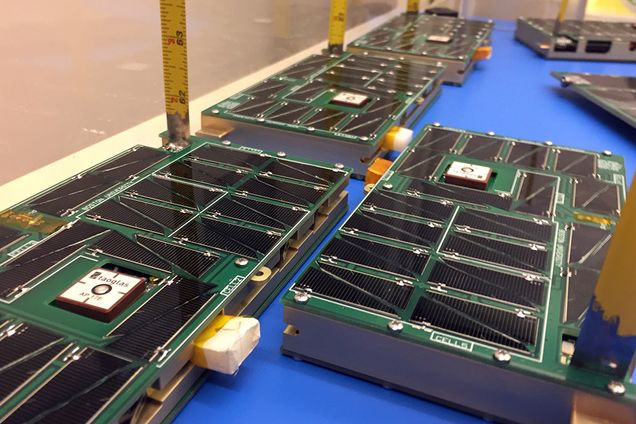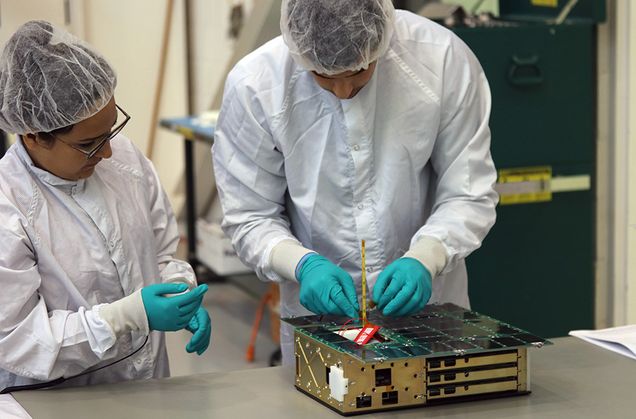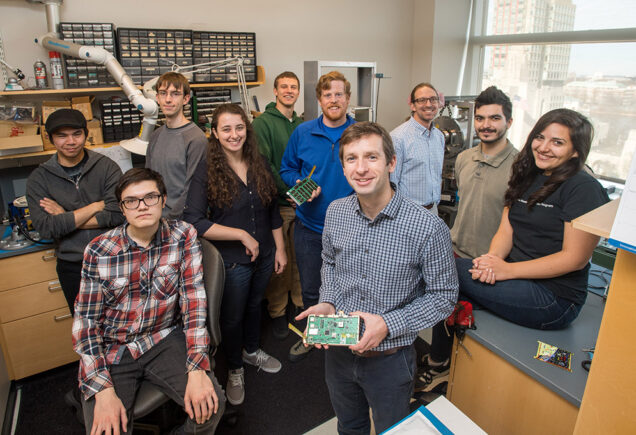NASA to Launch BU Student-Built Microsatellites
ANDESITE will get close-up look at the aurora
By Kate Becker, BU Today

If MacGyver were on a mission to study the aurora, this is the satellite he might build: a grid of scrap solar cells pasted onto an iPad-size green rectangle of circuit board, a six-inch cut of stainless steel tape measure soldered in one corner as a makeshift antenna, and inside, a suite of smartphone-class sensors that anyone can buy on the internet. But despite its crude looks, this microsatellite, a piece of a BU student-built experiment called ANDESITE, is actually on the leading edge of a new trend: studying space using wireless networks, or swarms, of inexpensive, lightweight minisatellites that are cheap to build and cheap to launch.
ANDESITE is on track to launch some time after March 1, 2018, as part of a satellite rideshare coordinated by NASA’s Educational Launch of Nanosatellites (ELaNa) Project. It’s a teaching mission first: roughly 15 College of Engineering students, including project manager J. Brent Parham (ENG’18) and project engineer Maria Kromis (ENG’17), are working on the project at any given time, gaining the kind of hands-on satellite-building experience that aspiring space engineers usually have to wait years for.
But ANDESITE is not just for practice. It will be examining how charged particles spilling out from the sun buffet the Earth’s magnetic field. This stream of particles, called the solar wind, can be a gentle breeze or a sudden, potentially hazardous gust that makes the Earth’s magnetic field flap like a wind sock in a hurricane.

“It was very important for us to have a true science mission. When it’s launched into space, we’re doing fundamentally new research,” says Brian Walsh (GRS’09,’12), an ENG assistant professor of mechanical engineering, who heads up the project with Joshua Semeter (ENG’92,’97), an ENG professor of electrical and computer engineering.
When solar wind particles hit the Earth’s magnetic field, they cram together and funnel through lanes marked off by the Earth’s magnetic field lines, like commuters squeezing through a bank of subway turnstiles. Then they drop down on the atmosphere, generating electrical currents that make the glowing, multicolored aurora—but they can also wreak havoc on radio communications and electrical systems below. By measuring the strength and direction of the magnetic field some 500 kilometers above Earth, ANDESITE will help reveal how those electrical currents move energy into the atmosphere, which could help researchers provide better predictions about potentially dangerous solar storms and understand how the aurora gets its peculiar ripples and whirls.
Until now, space physicists have studied these questions using single, high-precision spacecraft. But solo satellites have limitations, even when they are outfitted with top-of-the-line sensors, says Parham, who presented a mission update at the American Geophysical Union’s Fall Meeting, on December 13, 2017.

“If you’re flying one sensor through something really fast on a satellite, you’re just getting a time series of data,” says Parham. But because the aurora is always changing, it’s impossible to tell the difference between changes over time and changes over space: they are all mixed up together.
The satellites will take positions a few kilometers apart, circling the Earth every 90 minutes. Combining readings from all eight spacecraft, space physicists will be able to piece together a full picture of the aurora, even without exquisitely sensitive—and exquisitely expensive—parts. “We don’t need a finely tuned Ferrari: we advance our science with eight Camrys,” says Walsh.
Inside each of ANDESITE’s eight circuit-board satellites is a smart compass, made up of a magnetometer that reads out the strength of the magnetic field in three directions, plus a GPS device and a gyroscope, which tell where the satellite is and what way it’s pointed. Also onboard: a so-called baby microprocessor, popular with electronics hobbyists, a battery to store up energy from the solar cells, and the tape-measure antenna, which will send data back to the mothership. The total cost of parts for one minisatellite: about $500.

The deployer also slashes the cost of launch to pennies on the dollar: the face value of a rideshare ticket for a mission like ANDESITE is about $200,000, compared to at least $20 million to fly solo, Parham says. (ANDESITE’s spot is sponsored by NASA’s ELaNa program.)
These pocket-sized satellites are not about to replace the full-sized, bespoke flagships for every application, but Parham says he’s eager for ANDESITE to help prove that little satellites can do big science. “There’s something to be done with the cheap stuff,” he says. “You just have to realize that it’s not either/or.”
This article originally appeared on BU Today.